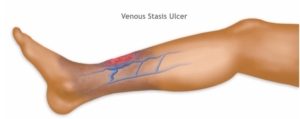Venous leg ulcers are a type of chronic wound that can be difficult to treat. They are typically caused by underlying venous disease, which can lead to poor blood flow in the legs and ankles. This can cause a buildup of fluid and pressure in the veins, which can then lead to the development of an ulcer. Venous ulcers are often slow to heal and can be painful and debilitating, which can greatly impact a patient’s quality of life.

Healing Venous Stasis Ulcers
Fortunately, there are a variety of treatment options available for venous ulcers, including wound care and compression therapy. In some cases, these treatments may be used in conjunction with other interventions, such as radiofrequency ablation (RFA). In this article, we will explore the use of wound care and compression therapy using Velcro wraps to treat a venous ulcer before RFA.
-
Wound Care for Venous Leg Ulcers
First is to initiate wound care. Wound Care for Venous Ulcers is essential for the treatment of venous ulcers. This may involve several different components, including cleansing the wound, removing any dead tissue or debris, and applying a dressing to promote healing. Dressings can vary in their composition and may be designed to manage exudate (fluid drainage), promote a moist environment, or debride the wound.
-
Compression Therapy for Venous Leg Ulcers
At the same time compression is a key component. Compression helps to reduce swelling and improve blood flow in the legs, which can then promote healing of the ulcer. Once the swelling is reduced it can have a profound effect on healing. Compression can be applied using a variety of methods, including bandages, stockings, or wraps.

If the leg is very swollen and if the wound is “messy”, velcro wraps are a type of compression wrap that can be particularly effective for managing venous ulcers early on. These wraps are made from a stretchy material that can be easily adjusted to fit the size and shape of the patient’s leg. They also feature Velcro closures that make them easy to apply and remove, even for patients with limited mobility. They can be applied over the wound dressing and adjusted as the swelling goes down. This is important because too much compression can be uncomfortable or even harmful, while too little compression may not be effective for promoting healing. Velcro wraps allow for precise control over the level of compression, which can be adjusted as needed based on the patient’s response to treatment.
Generally each day in compression there is less swelling, so the user can adjust the level of compression tighter each day to continue to reduce the swelling.
-
Ablation for Venous Leg Ulcers
An additional proven step is ablation of the superficial venous reflux using office based procedures such as Radiofrequency Ablation (RFA) of the great saphenous vein and sclerotherapy of the branch veins going to the ulcer bed.
Using Wound Care and Compression before RFA Radiofrequency ablation (RFA) is a proven approach to get wound closed and to help them stay closed for longer.
During the procedure, a catheter is inserted into the affected vein and heat is used to close off the vein. This helps to improve blood flow and reduce the risk of ulcers recurring. It is important to note that some wounds do not heal, and often these need to be seen also by a dermatologist who can assess and consider a biopsy in some cases for less common dermatologic disorders that can also impair healing.
-
Long-Term Management of Healed Venous Leg Ulcers
After the RFA procedure once the wound is healed, compression therapy will continue to be important components of the long term management. But at this point, with the wound closed and less swelling, the patient should be able to put on traditional compression hose rather than the velcro wraps.
Many patients who have had ulcers for years are quite surprised at the results, as were demonstrated in this clinical trial: https://www.nejm.org/doi/full/10.1056/NEJMoa1801214.
The key is to find a provider group like Inovia Vein that can help you start your vein care journey to better wound healing and quality of life.